Bilbo Baggins towed Angel at the Stoke Bruerne Gala Weekend.
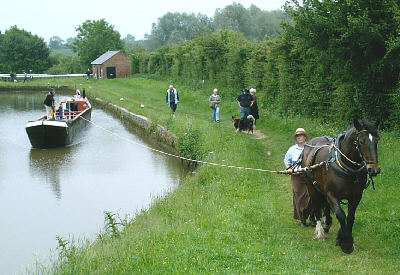
Bilbo Baggins and Angel at Stoke Bruerne Locks. Photo: Jim Payler.
Bilbo Baggins towed Angel at the Stoke Bruerne Gala Weekend.

Bilbo Baggins and Angel at Stoke Bruerne Locks. Photo: Jim Payler.
Bilbo Baggins towed Saturn for 5 miles from Audlem to Nantwich.
See photos of the journey.
Bilbo Baggins and Maria made a return journey of 45 miles and 148 locks to Huddersfield including being legged through Standedge Tunnel, Britain’s longest canal tunnel.
See photos.
Queenie and Maria made a return journey from Manchester to Liverpool for the World Canals Conference.
See more photos of the journey.
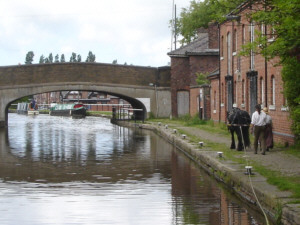
Passing Burcough Wharf, approaching Burscough Bridge.
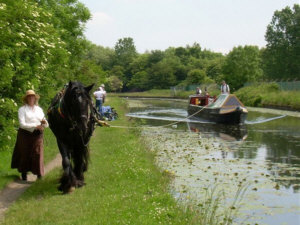
Arriving at Aintree, Queenie rounds “Canal Turn”.
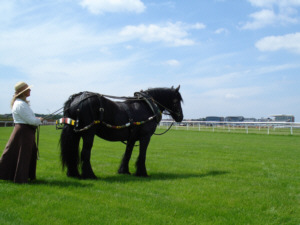
Queenie contemplates the prospect of a run around the Grand National course!
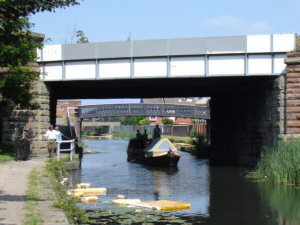
Caroline Street changeline bridge and railway bridge, Bootle.
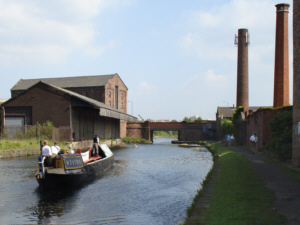
“Maria” passes old canal warehouses at Bank Hall.
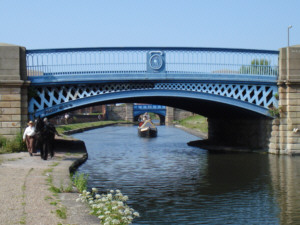
Approaching Eldonian Village, Liverpool, nearing journey’s end.
The BBC North West programme “Inside Out” broadcast on 23rd October featured an item showing Bonny towing Saturn.
Following the broadcast, Sue Day took part in a live “web chat”, answering viewers’ questions.
You can read the questions and answers here.
Two men united with Maria, against the Defra cuts
What started out as a pleasure cruise eventually turned into a protest cruise. Two guests of honour supported the efforts of The Horseboating Society. One represents British Waterways, the other is an MP.
On August 4, 2006, Robin Evans, chief executive of British Waterways, joined horseboat Maria at Portland Basin where the Lower Peak Forest Canal meets the Ashton Canal. Robin came with his wife Hilary to experience a full day of horseboating on a stretch of canal including turnover bridges, 2 tunnels, Marple Aqueduct, and the Marple flight of 16 locks. They would be engaged in operating the horseboat as it was intended when the canals were built for these craft.
After a long car drive, Robin and Hilary chose to walk on the towpath with boathorse Queenie initially. The towline was passed over railings, over anglers, and a moored boat, and around a lampost, and carefully worked on the turnover bridges. Hilary had a taster session of driving Queenie along a quiet section of towpath.
Our guests then boarded Maria, Britain’s oldest surviving wooden narrowboat, built in 1854 at Marple. Queenie pulled Maria through Woodley Tunnel but it was Robin who took Maria through Hyde Bank Tunnel by legging from the back cabin roof. His big smiles on exiting the tunnel suggest he was pleased with his solo effort!
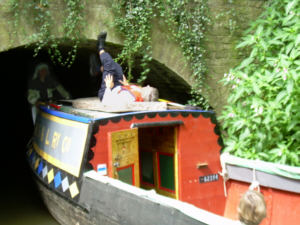
Robin legs horseboat Maria through Hyde Bank Tunnel on the Lower Peak Forest Canal.
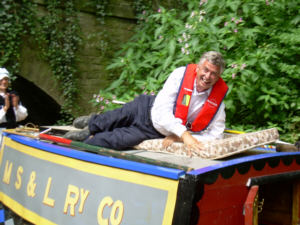
Is Robin pleased with his efforts or relieved it’s all over?
Robin then steered Maria to the bottom of the locks, including passing over the splendid Marple Aqueduct. After our long sociable lunch break, Bonny The Boathorse took over from Queenie up the locks. Robin explained he had to attend to a conference call, so we started on the locks as he walked up beside Maria.
Robin was visibly upset by the call which confirmed further Defra cuts. Hilary advised Robin to tell Bonny The Boathorse about it all, “as Bonny understands everything”. Our pleasant day out was in jeopardy if we gave vent to our feelings now about Defra cuts. Robin and Hilary helped work the long flight of locks and photos were taken of the happy crew at the top, of “Robin and His Merry Band”.
Together we had all brought Maria to the very location where she was built at the boatyard of James Jinks in 1854. We had arrived at the 40th Anniversary Rally of the Historic Narrow Boat Owners’ Club (HNBOC).
We waved goodbye to Robin and Hilary and invited them to come again.
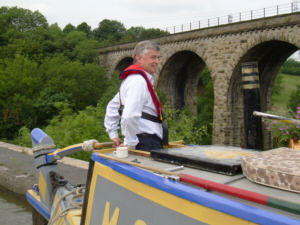
Robin steers maria across Marple Aqueduct.
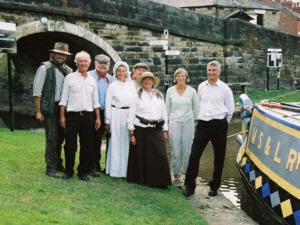
Robin and his Merry Band at Marple Junction!
The following day was an easy cruise for us along the Upper Peak Forest to Bugsworth Basin. We followed at the end of the HNBOC Club Cruise, in order to make sure we did not hold other boats up if we were delayed with towline problems over moored boats. Our arrival at Bugsworth was filmed by i2i television for the series “Narrow Boat Afloat”.
Maria was now loaded with some 18 tons of limestone, all shovelled on by hand. The boat is owned by the Ashton Packet Boat Co. and with their friends helping, the boat was soon loaded. Due to the intense heat of the previous month, the wooden planks of Maria had dried and shrunk. As she lowered in the canal, water began to leak in. Pumps were urgently employed to keep abreast of the leaks. Members of HNBOC rallied to help. One was in the water forcing clay into seams. Others brought ash from their cabin stoves to plug seams. Very gradually, Maria’s planks began to swell again, because they were immersed underwater.
Queenie brought the loaded boat back over two days to the Ashton Canal. This was a re-enactment of the trade in which Maria was engaged from 1854 to circa 1904. She was still travelling the very same waters. This was the longest journey so far undertaken by HBS with a well loaded boat, covering 16 miles and 16 locks. Maria ran aground in 2 bridgeholes. It should be remembered that canals are not dredged as deeply as in the past, making towing harder work for a boathorse. Queenie did admirably.
We were advised we would be unlikely to reach Manchester fully loaded so some limestone was removed. On Friday October 13th, we set out again. We were on our way to the 10th anniversary celebrations of the Bridgewater Hall, the world class music venue on the Rochdale 9. HBS members were off to the Gala Concert. We were seeking media coverage about the Defra cuts as Maria went into the heart of Manchester’s canals, recently praised by John Prescott, Deputy Prime Minister, as an “engine” for regeneration of the city. Horseboating here is difficult and potentially dangerous, involving underground horseboating in dark locations, and detours on city streets due to current construction works. Arriving safely, Maria entered the padlocked Bridgewater Hall Basin for the first time for an overnight stay. The Manchester Evening News photographed her arrival. BBC Radio Manchester did two interviews with us that day. All were alarmed that Manchester’s canals might close.
On the Saturday the HBS crew were joined by extra supporters. Many of us were members of IWA Manchester Branch, local cruising clubs affiliated to AWCC, the Historic Narrowboat Owners Club, and Friends of President too. David Heyes, MP, whose constituency covers some of the Rochdale and Ashton Canals phoned to assure us that he would meet us soon as invited. David has a keen interest in canals, regarding their industrial archaeology and proven ability to act as catalysts for regeneration. Earlier this year David introduced The Abandoned Waterways Bill.
Due to ongoing construction work, Queenie detoured by city streets to gain access to the Ashton. David with his wife Judith watched our approach to lock 2. They were welcomed aboard Maria, enjoying a short cruise to our lunch spot. This was determined by ample grazing being available for Queenie on parkland above lock 4.
A lengthy lunchbreak to rest horse and crew enabled David to talk to all members of crew in a very relaxed manner. We discussed the concerns that our local canals might close, and David was able to ask us questions which bothered him. He asked about the reported lack of use of the Rochdale. One of the crew explained she had been made redundant because during her job with a community canalboat, the canal had been closed for 21 months out of 24. We described how such uncertainty made it difficult for boaters to plan a through cruise. We praised BW for attending to repairs and lamented the huge costs that BW had been suffering. We talked about the fact that there were fewer boat owners in the north than the south, and how societies like ours could enable anyone to join in, increasing user numbers.
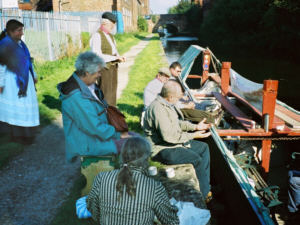
David talks with the crew of Maria.
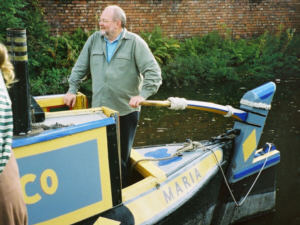
David takes the tiller.
After lunch, David enjoyed steering Maria on his local canal past the Commonwealth Games Stadium, now home to Manchester City. Football supporters were streaming along the towpath, many stopping to watch the horse and boat, others hurrying on to their game. So David saw the canal in use by boaters and many walkers.
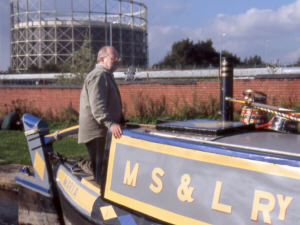
David steers Maria along the Ashton Canal.
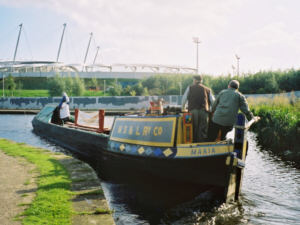
Approaching the former Commonwealth Stadium.
When David left, he was given copies of recent waterway press to provide him with articles about the Defra cuts. He assured us he would work for a rethink in Defra and the Treasury. He was quick to sign up to the Early Day Motion 2757 drawing the government’s attention to the need for full funding of navigation authorities to be reinstated.
Maria, her job well done, travelled to her home moorings at Guide Bridge on the Ashton Canal to be unloaded soon afterwards.
[Photographs on this page courtesy of Chris Smyth, Nigel Dix, Bob Jervis and Heather & David Howarth.]For more photos of this journey, see this page.
Maria was horseboated to the Historic Narrow Boat Owners’ Club Rally at Marple, then on to Bugsworth Basin, where she was loaded with limestone to bring back to the Ashton Canal. On the way to Marple, BW’s Chief Executive, Robin Evans, joined the crew and legged a tunnel, steered the boat and worked the locks!
See photos of journey.
Members of The Horseboating Society legged “Maria” through Standedge Tunnel as part of a special celebration to mark the 200th anniversary of Thomas Telford’s appointment to finish the tunnel.
The Horseboating Society’s big event for 2006 included two attempts by society members to leg Standedge Tunnel – the highest, longest and deepest canal tunnel in the country – on 7th and 14th May. These special events were being held by British Waterways as part of a double celebration at Standedge in 2006: the fifth anniversary of the reopening of the Tunnel and the 200th anniversary of Thomas Telford’s appointment to finish the tunnel.
The horsedrawn boat Maria left Ashton on May 4th to make the full canal journey to Huddersfield and returned by May 15th. Bonny and Queenie provided the horsepower.
On Sunday, 7th May, a team from the Horseboating Society legged the tunnel from Diggle to Marsden in relays of two people at a time. The boat used was the historic horseboat Maria, built in 1854 and believed to have carried limestone into the Colne Valley until 1900.
On Sunday 14th May, one member, Nigel Dix, legged the whole tunnel length from Marsden to Diggle. Bonny the Boathorse walked ‘over the top’ on both legging days while the boat was legged through the tunnel and visitors were invited to join her along Boat Lane.
On both Sundays there was also free entertainment at Standedge Visitor Centre between 12 noon until 4 pm. Visitors were able to take part in traditional games and saw waterway crafts including harness making, ropework, such as making towlines and splicing, and demonstrations on a pole-lathe. Characters dressed in costume added to the atmosphere and members of the Huddersfield Canal Society were on hand to talk about the history of the Huddersfield Narrow Canal and its restoration.

Legging through Standedge Tunnel.

Preparing to leg ‘solo’.
The Ashton Packet Boat Company’s historic wooden narrowboat “Maria”, built in 1854, made the horsedrawn journey along the Huddersfield Narrow Canal between Ashton and Huddersfield and back, including being the first boat legged through Standedge Tunnel for 59 years. The passage through the tunnel took 2 hours 52 minutes. Click here for photos.
On the return journey, the boat was legged solo through the tunnel by Horseboating Society member Nigel Dix in a time of 3 hrs 3 minutes. Click here for photos.